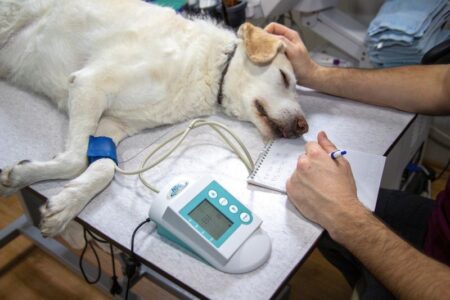Cancer is a prevalent and unfortunate disease that can affect not only humans but also our beloved pets, such as dogs. It is crucial to keep a close eye on our furry friends to ensure their well-being and catch any signs of illness, including cancer.
In this article, we will explore the signs that may indicate a dog is dying of cancer. By being attentive and proactive, we can provide the necessary love and care during this challenging time for our canine companions.
15 Signs A Dog Is Dying Of Cancer
Here are 15 signs that may indicate a dog is dying of cancer:
Changes in behavior:
One of the first signs that might indicate cancer in dogs is a noticeable change in their behavior. They may become more withdrawn, less active, or show a decreased interest in their favorite activities. Additionally, dogs nearing the end of their battle with cancer may display signs of depression or restlessness.
Changes in appetite and weight loss:
Cancer can impact a dog’s appetite and cause significant weight loss. A dog suffering from cancer may either have a reduced appetite or refuse to eat altogether. Even if they continue to eat, they may not be able to absorb nutrients efficiently, resulting in gradual weight loss.
Lumps, bumps, or swelling:
Unexplained lumps, bumps, or swelling that do not go away should be a cause for concern.
Difficulty breathing:
Cancer can affect the lungs, leading to coughing, wheezing, or labored breathing.
Chronic pain:
Dogs with cancer may exhibit signs of chronic pain, such as whimpering, reluctance to move or be touched, or changes in posture.
Changes in bathroom habits:
Cancer can affect the gastrointestinal system, leading to changes in a dog’s bowel movements, including diarrhea or constipation.
Unexplained bleeding:
Any unexplained bleeding, such as from the nose, mouth, or rectum, could be a symptom of cancer in dogs.
Fatigue and weakness:
Dogs may appear more tired, lack energy, or show signs of weakness, even with less physical activity.
Vomiting or regurgitation:
Dogs with cancer may experience vomiting or regurgitation, especially if the cancer is affecting their digestive system.
Difficulty swallowing:
Tumors in the throat or esophagus can make it difficult for dogs to swallow food or water.
Persistent cough:
A persistent cough that does not go away, or worsens over time, can be a sign of lung or respiratory cancer.
Changes in urination:
Dogs with cancer may experience increased frequency in urination, difficulty urinating, or blood in the urine.
Rapid or unexplained weight loss:
Sudden and significant weight loss can be a sign that the cancer is progressing and affecting the dog’s overall health.
Inability to walk or stand:
Dogs may become weak, lose coordination, or struggle to walk or stand due to cancer affecting the bones, joints, or nervous system.
Loss of interest in surroundings or people:
As the disease progresses, dogs may withdraw from their surroundings and lose interest in things or people they once enjoyed.
Does a Certain Stage of Cancer Mean That My Dog Is Dying?
While a certain stage of cancer can indicate that a dog’s condition is progressive and potentially life-threatening, it does not necessarily mean that the dog is immediately dying. Staging in cancer refers to determining the extent and spread of the disease within the body. Different staging systems are used depending on the type of cancer.
The stages of cancer can give veterinarians a general idea of the prognosis and help guide treatment options. However, each dog’s response to cancer can vary, and numerous factors contribute to their overall health and survival.
It’s important to remember that a cancer diagnosis does not provide a specific timeline for a dog’s lifespan. Some dogs may have a more aggressive form of cancer and experience a rapid decline in health, while others may have a slower-progressing form and maintain a good quality of life for an extended period.
SEE ALSO: Why Schnauzers Are The Worst Dogs
Cancer in Dogs
Cancer is a common and unfortunate disease that can affect dogs of all ages and breeds. Just like in humans, cancer in dogs occurs when normal cells in their body undergo abnormal growth and division, forming masses of cells called tumors. These tumors can be benign (non-cancerous) or malignant (cancerous), and they can arise in various parts of the body.
The Stages of Dog Cancer
Here are the stages of dog cancer:
Stage 0: This stage is used to describe cancer that is in situ, meaning it has not invaded surrounding tissues or spread elsewhere in the body. The tumor is localized and has not grown beyond its point of origin.
Stage I: At this stage, the cancer is considered localized but has started to invade nearby tissues. The tumor may be growing in size but has not spread to distant organs or lymph nodes.
Stage II: Cancer at this stage has grown and invaded nearby tissues extensively. However, it has not yet spread to lymph nodes or distant organs.
Stage III: Cancer at this stage has spread to regional lymph nodes but has not reached distant organs. The primary tumor may still vary in size and invasiveness.
Stage IV: This stage indicates the presence of metastasis, where cancer has spread to distant organs or spread extensively to multiple lymph nodes. The primary tumor may have grown significantly, and secondary tumors are present in other parts of the body.
Diagnosing Cancer in Dogs
There are several ways that veterinarians can diagnose cancer in dogs. The most common way is to take a biopsy, which involves removing a small piece of tissue from the suspected tumor and sending it to a lab for analysis. Other diagnostic tests that may be performed include radiographs (x-rays), ultrasounds, CT scans, MRI, and biopsies of the bone marrow or lymph nodes. Blood tests can also help diagnose cancer in dogs. In some cases, the results of these tests may be inconclusive, and further testing may be needed to confirm a diagnosis.
Signs of Stomach Cancer in Dogs
Here are some possible signs of stomach cancer in dogs:
- Decreased appetite: Dogs with stomach cancer may show a reduced interest in eating or have a decreased appetite.
- Weight loss: Unexplained weight loss can occur in dogs with stomach cancer, even if their appetite remains normal or decreased.
- Vomiting: Persistent or recurring vomiting, especially after eating or drinking, can be a sign of stomach cancer in dogs.
- Abdominal pain: Dogs with stomach cancer may exhibit signs of discomfort or pain in the abdominal area. They may show reluctance to be touched or display changes in behavior, such as restlessness or aggression.
- Weakness and lethargy: Dogs with stomach cancer may experience decreased energy levels, generalized weakness, and increased fatigue.
- Decreased stool quality: Stomach cancer can affect the digestive system, leading to changes in stool quality, such as diarrhea or loose stools.
- Blood in vomit or stool: The presence of blood in the vomit (hematemesis) or stool (melena) can be a concerning sign and may indicate stomach cancer in dogs.
- Pale gums: Stomach cancer can lead to anemia in dogs, resulting in pale gums or mucous membranes.
How Do I Know If My Dog With Cancer Is Suffering?
Determining whether your dog with cancer is suffering can be difficult, but there are some signs you can look for. If your dog has decreased appetite or is not eating at all, this could be a sign that they are in pain or discomfort. Other signs to look for include decreased energy or activity, difficulty breathing, changes in weight, and changes in behavior. If you think your dog may be suffering, it’s important to talk to your veterinarian to find out what can be done to help them. In some cases, pain medications or other treatments may be able to help your dog feel more comfortable.
Dog Cancer Treatments
Here are some common treatments for dog cancer:
- Surgery: Surgery is often the primary treatment for localized tumors. It involves removing the cancerous tumor along with a margin of healthy tissue to ensure complete removal. The extent of surgery depends on the type, stage, and location of the cancer.
- Chemotherapy: Chemotherapy uses drugs to kill or slow down the growth of cancer cells. It is commonly used in cases where cancer has spread or as an adjuvant treatment after surgery to prevent or delay recurrence. Chemotherapy can be administered orally, intravenously, or through injection.
- Radiation Therapy: Radiation therapy utilizes high-energy rays to target and kill cancer cells. It is often used to shrink tumors before surgery or to destroy remaining cancer cells after surgery. Radiation therapy is usually administered over several weeks, with careful monitoring to minimize side effects.
- Immunotherapy: Immunotherapy stimulates the dog’s immune system to target and destroy cancer cells. This treatment can include vaccines, immune-boosting drugs, or targeted therapies that block specific pathways involved in cancer growth.
- Palliative Care: In cases where a cure is not possible, palliative care focuses on providing comfort, pain management, and improving the dog’s quality of life. This can include medications to control pain, manage symptoms, and provide supportive care.
- Clinical Trials: In certain situations, veterinarians may recommend enrolling a dog in a clinical trial to explore experimental treatments or new therapies that are not yet widely available. Clinical trials help advance cancer treatment options for dogs.
My Dog Has Cancer When Do I Put Him Down?
This is a difficult question to answer, as every situation is different. It’s important to consider your dog’s quality of life when deciding whether or not to put them down. If your dog is in constant pain, has lost their appetite, or is having difficulty breathing, it may be time to consider euthanasia. On the other hand, if your dog is still able to enjoy life and is not in pain, you may decide to continue treatment or palliative care. It’s always best to consult with your veterinarian and make a decision based on your dog’s circumstances.
How to Evaluate Quality of Life in a Dog with Cancer
Evaluating the quality of life of a dog with cancer can be challenging, but there are some key factors to consider. First, assess your dog’s energy level. A dog that is still able to enjoy walks, play with toys, and interact with their owners likely has a good quality of life. Second, look at your dog’s appetite. If they are still eating and drinking normally, this is a good sign. Third, consider your dog’s ability to sleep and rest comfortably. Finally, take into account any signs of pain or discomfort. If your dog is showing signs of pain or suffering, it may be time to consider euthanasia.
SEE ALSO: Can Dogs Eat Cornbread?
Conclusion
Cancer is a devastating disease that can affect our beloved dogs. Recognizing the signs that a dog may be nearing the end of their battle with cancer is crucial for providing them with the care and support they needs during this difficult time. Some of the signs to watch out for include changes in behavior, appetite, and weight loss, the presence of lumps or bumps, difficulty breathing, chronic pain, changes in bathroom habits, unexplained bleeding, fatigue and weakness, and loss of interest in surroundings or people.


